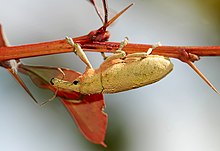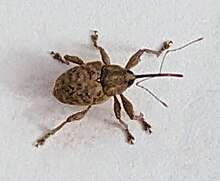
Back Wīfel ANG سوسينات Arabic سوسينات ARZ উইভিল Bengali/Bangla Curculionoïdeus Catalan Curculionoidea CEB Curculionoidea Czech Gwiddonyn (chwilen) Welsh Rüsselkäfer German Curculionoidea Spanish
| Weevils Temporal range:
| |
|---|---|

| |
| Lixus pulverulentus | |
| Scientific classification | |
| Domain: | Eukaryota |
| Kingdom: | Animalia |
| Phylum: | Arthropoda |
| Class: | Insecta |
| Order: | Coleoptera |
| Suborder: | Polyphaga |
| Infraorder: | Cucujiformia |
| Clade: | Phytophaga |
| Superfamily: | Curculionoidea Latreille, 1802 |
| Families | |
Weevils are beetles belonging to the superfamily Curculionoidea, known for their elongated snouts. They are usually small – less than 6 mm (1⁄4 in) in length – and herbivorous. Approximately 97,000 species of weevils are known. They belong to several families, with most of them in the family Curculionidae (the true weevils). It also includes bark beetles, which while morphologically dissimilar to other weevils in lacking the distinctive snout, is a subfamily of Curculionidae. Some other beetles, although not closely related, bear the name "weevil", such as the biscuit weevil (Stegobium paniceum), which belongs to the family Ptinidae.
Many weevils are considered pests because of their ability to damage and kill crops. The grain or wheat weevil (Sitophilus granarius) damages stored grain, as does the maize weevil (Sitophilus zeamais), among others. The boll weevil (Anthonomus grandis) attacks cotton crops; it lays its eggs inside cotton bolls and the larvae eat their way out. Other weevils are used for biological control of invasive plants.
A weevil's rostrum, or elongated snout, hosts chewing mouthparts instead of the piercing mouthparts that proboscis-possessing insects are known for. The mouthparts are often used to excavate tunnels into grains.[1] In more derived weevils, the rostrum has a groove in which the weevil can fold the first segment of its antennae.
Most weevils have the ability to fly (including pest species such as the rice weevil),[2][3] though a significant number are flightless, such as the genus Otiorhynchus.
One species of weevil, Austroplatypus incompertus, exhibits eusociality, one of the few insects outside the Hymenoptera and the Isoptera to do so.

- ^ Moon, Myung-Jin (2015). "Microstructure of mandibulate mouthparts in the greater rice weevil, Sitophilus zeamais (Coleoptera: Curculionidae)". Entomological Research. 45 (1): 9–15. doi:10.1111/1748-5967.12086. ISSN 1748-5967. S2CID 82634306.
- ^ "What Is a Weevil and How Did That Bug Get in My Food?".
- ^ "Weevils on Stored Grain (Department of Entomology)". Department of Entomology (Penn State University).